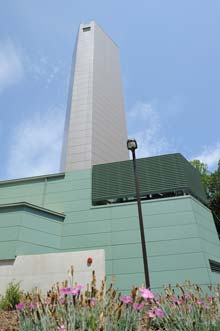| A new technology
could reduce capital costs and improve safety.

Small nuke: This testing facility will be used to demonstrate
a scaled-down version of a new modular nuclear design by Babcock &
Wilcox. The tower will test the gravity-fed emergency cooling system.
Credit: Babcock & Wilcox
One of the biggest obstacles to constructing
nuclear power plants is that they tend to be extremely large and expensive.
Now one utility is taking steps toward constructing a plant that uses small
modular reactors that can be built faster and more cheaply than conventional
ones. This week the Tennessee Valley Authority signed a letter of intent
with nuclear-reactor maker Babcock & Wilcox to work together to build
up to six small reactors near Clinch River, Tennessee. If the plan goes
ahead, these could be the first small modular commercial nuclear power
plants. |
The plan comes
at a time when many nuclear projects are stalled because of safety concerns
and also for reasons of cost. Babcock & Wilcox's modular reactors require
less capital than conventional ones, and they have some safety advantages
as well. The letter of intent does not guarantee that the plants will be
built, according to TVA, but it will start work on the engineering needed
to undertake the extensive nuclear-plant permit process and environmental
reviews of the site. Last year, TVA initiated discussions with the Nuclear
Regulatory Commission on how to proceed with licensing the novel small
nuclear-reactor design.
In the past, utilities have preferred very
large nuclear reactors—over 1,000 megawatts—to take advantage of economies
of scale. But large reactors have a long lag time between when funding
is raised and when the plant starts generating revenue, and this creates
a problem, says Andrew Kadak, a former professor of nuclear engineering
at MIT and a consultant at Exponent Failure Analysis. When the cost of
interest is figured in, smaller reactors look more attractive. Lenders
are typically willing to charge less interest on smaller loans, and the
plants can be expected to start generating revenue faster. TVA's are projected
to take three years to build, as opposed to five or more for conventional
plants. Smaller reactors also avoid the need for expensive transmission
upgrades to link them to the grid. |